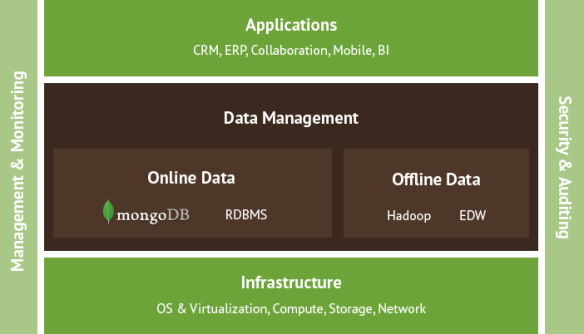
MongoDB is a cross-platform document-oriented database system. Classified as a “NoSQL” database, MongoDB eschews the traditional table-based relational database structure in favor of JSON-like documents with dynamic schemas (MongoDB calls the format BSON), making the integration of data in certain types of applications easier and faster. Released under a combination of the GNU Affero General Public License and the Apache License, MongoDB is free and open source software.
First developed by the New York City-based company 10gen (now MongoDB Inc.) in October 2007 as a component of a planned platform as a service product, the company shifted to an open source development model in 2009, with 10gen offering commercial support and other services.Since then, MongoDB has been adopted as backend software by a number of major websites and services, including Craigslist, eBay, Foursquare, SourceForge, and The New York Times, among others. MongoDB is the most popular NoSQL database system.
The following is a brief summary of some of the main features:
Ad hoc queries
MongoDB supports search by field, range queries, regular expression searches. Queries can return specific fields of documents and also include user-defined JavaScript functions.
Indexing
Any field in a MongoDB document can be indexed (indices in MongoDB are conceptually similar to those in RDBMSes). Secondary indices are also available.
Replication
MongoDB supports master-slave replication. A master can perform reads and writes. A slave copies data from the master and can only be used for reads or backup (not writes). The slaves have the ability to select a new master if the current one goes down.
Load balancing
MongoDB scales horizontally using sharding. The developer chooses a shard key, which determines how the data in a collection will be distributed. The data is split into ranges (based on the shard key) and distributed across multiple shards. (A shard is a master with one or more slaves.)
MongoDB can run over multiple servers, balancing the load and/or duplicating data to keep the system up and running in case of hardware failure. Automatic configuration is easy to deploy, and new machines can be added to a running database.
File storage
MongoDB could be used as a file system, taking advantage of load balancing and data replication features over multiple machines for storing files. This function, called GridFS,is included with MongoDB drivers and available with no difficulty for development languages (see “Language Support” for a list of supported languages). MongoDB exposes functions for file manipulation and content to developers. GridFS is used, for example, in plugins for NGINX and lighttpd.
In a multi-machine MongoDB system, files can be distributed and copied multiple times between machines transparently, thus effectively creating a load balanced and fault tolerant system.
Aggregation
MapReduce can be used for batch processing of data and aggregation operations. The aggregation framework enables users to obtain the kind of results for which the SQL GROUP BY clause is used.
Server-side JavaScript execution
JavaScript can be used in queries, aggregation functions (such as MapReduce), are sent directly to the database to be executed.
Capped collections
MongoDB supports fixed-size collections called capped collections. This type of collection maintains insertion order and, once the specified size has been reached, behaves like a circular queue.
Main drawbacks
The following is a brief summary of some of the main drawbacks:
Database-level locking
MongoDB locks an entire database for each write, restricting concurrency.
Non-durable un-verifiable writes
MongoDB returns when not even data is securely written to non-volatile storage. Prior to version 2.2 it did not even wait for the data to be written to any server.
Scalability issues
It has scalability issues for more than 100GB of data.
Language support
MongoDB has official drivers for a variety of popular programming languages and development environments.Web programming language Opa also has built-in support for MongoDB, which is tightly integrated in the language and offers a type-safety layer on top of MongoDB.There are also a large number of unofficial or community-supported drivers for other programming languages and frameworks.
Read More: https://www.mongodb.com/products/mongodb
Source: Wikipedia Post by: Aneesh Sivan

